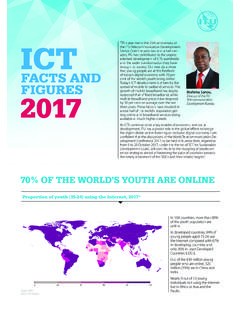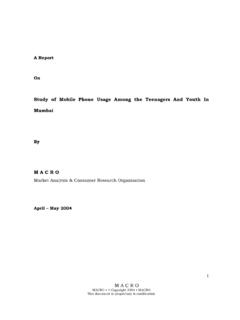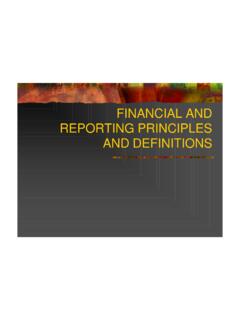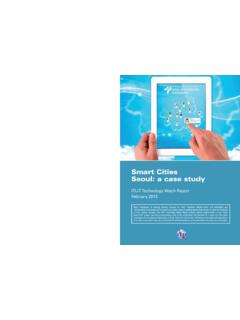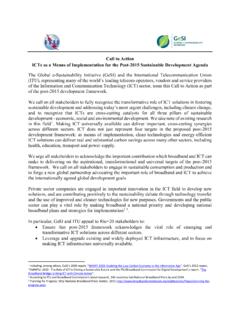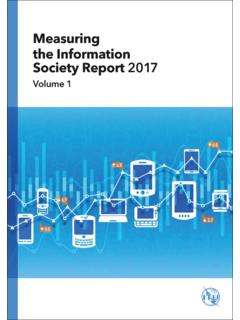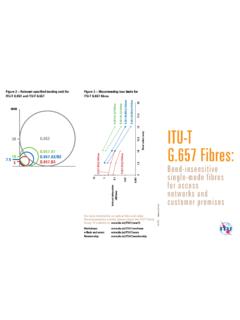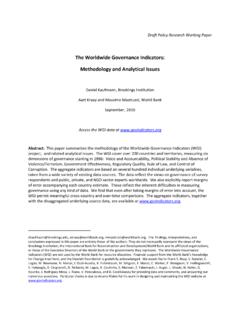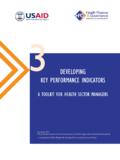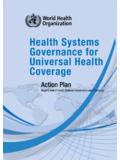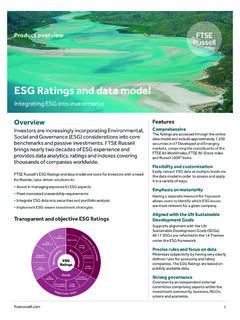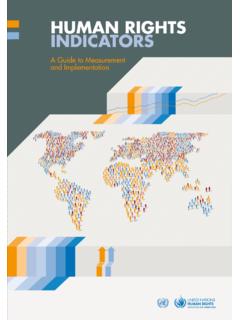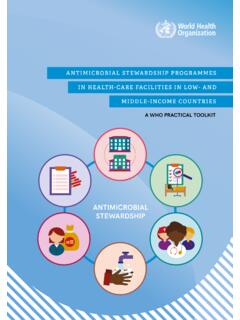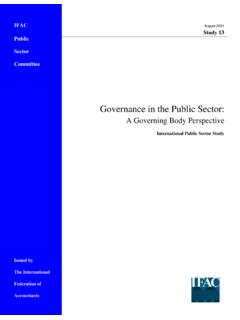Transcription of Key Performance Indicators (KPIs) and Standards for Smart ...
1 ITU ACADEMY Module 3: Key Performance Indicators (KPIs) and Metrics for SSCs Key Performance Indicators (KPIs) and Standards for Smart Sustainable Cities Smart Sustainable Cities Training Programme, Module SSC-3 1 ITU ACADEMY Module 3: Key Performance Indicators (KPIs) and Metrics for SSCs Contents Aim of this Module Overview of KPIs for SSCs KPI definitions for SSCs KPI level and usage of ICT for SSCs Metrics and evaluation of KPIs for SSCs KPIs related to the sustainability impacts of ICT in SSCs Review of standardization activities and gaps for SSC 2 ITU ACADEMY Module 3: Key Performance Indicators (KPIs) and Metrics for SSCs Aims of this Module To provide an overview of KPIs To enable you to understand the scope and priorities for SSCs To enable you to understand how ICT Performance can be measured in its own sector To enable you to understand the impact of ICT on the KPIs of other sectors To show how emerging Standards can allow comparisons to be made between one year and another or one city and another 3 ITU ACADEMY Module 3: Key Performance Indicators (KPIs) and Metrics for SSCs KPI Overview 4 ITU ACADEMY Module 3: Key Performance Indicators (KPIs) and Metrics for SSCs How do KPIs work?
2 Key Performance Indicators define sets of values against which to measure These raw sets of values, which are fed to systems in charge of summarizing the information, are called Indicators Indicators are identifiable and marked as possible candidates for KPIs They can be summarized into sub-categories 5 Source: ITU ACADEMY Module 3: Key Performance Indicators (KPIs) and Metrics for SSCs Benefits of SSC KPI Development For city dwellers and non-profit citizen organizations by enabling them to understand the development and progress of SSC with respect to ICT's impact. For the development and operation of SSC organizations, including planning units, service providers, operation and maintenance organizations, among others by helping them to fulfil the tasks of sharing information related to the use of ICTs and their impact on the sustainability of cities.
3 For evaluation and ranking agencies, including academia by supporting them in the selection of relevant KPIs for assessing the contribution from ICT in the development of SSC. 6 Source: FG-SSC Key Performance Indicators definitions for Smart sustainable cities, page 7 ITU ACADEMY Module 3: Key Performance Indicators (KPIs) and Metrics for SSCs Overview of KPIs #1 The proposed set of KPIs focuses specifically on a set of ICT related Indicators for Smart sustainable cities but does not cover all KPIs of cities contained in the ISO standard 37120 [ISO 37120]. The dimensions of KPIs can be categorized as Information and Communication Technology Environmental sustainability Productivity Quality of life Equity and social inclusion Physical infrastructure 7 Source: FG-SSC Overview of key Performance Indicators in Smart sustainable cities , Page 3 ITU ACADEMY Module 3: Key Performance Indicators (KPIs) and Metrics for SSCs Overview of KPIs #2 Each dimension is subdivided into further KPIs One example is illustrated for ICTs (D1) 8 ICT Network and access Services and information platforms Information security and privacy Electromagnetic field Source.
4 FG-SSC Overview of key Performance Indicators in Smart sustainable cities , Page 4 ITU ACADEMY Module 3: Key Performance Indicators (KPIs) and Metrics for SSCs Overview of KPIs #3 The other 5 dimensions are not specifically in the ICT sector but can benefit from the use of ICT to improve their own Performance as measured by KPIs 9 Source: FG-SSC Overview of key Performance Indicators in Smart sustainable cities , Pages 6-9 ITU ACADEMY Module 3: Key Performance Indicators (KPIs) and Metrics for SSCs Next: KPI Definitions for SSCs 10 ITU ACADEMY Module 3: Key Performance Indicators (KPIs) and Metrics for SSCs Selection of KPIs is based on the following principles Comprehensiveness: The set of Indicators should cover all the aspects of SSC and be aligned to ICT and its impact on the sustainability of cities The indices should reflect the level of general development in a certain aspect Comparability: The KPIs should be defined in a way that data can be compared scientifically between different cities according to different phases of urban development, which means the KPIs must be comparable over time and space.
5 Availability: The KPIs should be quantitative and the historic and current data should be either available or easy to collect. Independence: The KPIs in the same dimension should be independent or almost-orthogonal , overlap of the KPIs should be avoided as much as possible. Simplicity: The concept of each indicator should be simple and easy to understand the calculation of the associated data should be intuitive and simple Timeliness: The ability to produce KPIs with respect to emerging issues in SSC construction or stage or development 11 Source FG-SSC Key Performance Indicators related to the use of information and communication technology in Smart sustainable cities , Page 4 ITU ACADEMY Module 3: Key Performance Indicators (KPIs) and Metrics for SSCs How are KPIs chosen?
6 The FG-SSC made a comparative analysis of nineteen different index sets regarding KPIs and evaluation index systems of Smart cities and sustainable cities, etc. * The core Indicators are chosen as applicable to all cities** Additional- Indicators Reflect the degree of smartness and sustainability which differs between cities Thus, based on their stage of economic development or/and population growth etc., the cities can also select appropriate Indicators among those listed in Appendix I and/or use new ones. 12 Source: *FG-SSC Key Performance Indicators definitions for Smart sustainable cities , Page 8 and Key Performance Indicators related to the sustainability impacts of information and communication technology in Smart sustainable cities , page 2 ITU ACADEMY Module 3.
7 Key Performance Indicators (KPIs) and Metrics for SSCs Sub Dimensions of KPIs #1 Each Dimension can be broken down into Sub-Dimensions For example a KPI for ICT can be broken down into Network and access Services and information platforms Information security and privacy Electromagnetic field (Each sub dimension may be given a score and weighting which contributes to the overall KPI) 13 Source: FG-SSC Overview of key Performance Indicators in Smart sustainable cities Page 4 ITU ACADEMY Module 3: Key Performance Indicators (KPIs) and Metrics for SSCs Sub Dimensions of KPIs #2 Network and access refers to the network layer in the Open Systems Interconnection (OSI) model, especially backbone and access networks, including optical broadband, wireless broadband and broadcasting network.
8 Services and information platforms refers to ICT services and equipment above the network layer, including software services and private handsets. 14 Source: FG-SSC Overview of key Performance Indicators in Smart sustainable cities , Page 4 ITU ACADEMY Module 3: Key Performance Indicators (KPIs) and Metrics for SSCs Sub Dimensions of KPIs #3 Information security and privacy refers to the security parts including privacy protection. Electromagnetic field Application of exposure guidelines, consistent planning approval process and information for public should be considered with respect to Electromagnetic fields. 15 Source: FG-SSC Overview of key Performance Indicators in Smart sustainable cities , Page 4 ITU ACADEMY Module 3: Key Performance Indicators (KPIs) and Metrics for SSCs Other Sub-Dimensions #1 Environmental sustainability Air quality, CO2 emissions, Energy, Indoor pollution, water , soil and noise Productivity Capital investment, Employment, Inflation, Trade, Savings, Export/import, Household income/consumption, Innovation, Knowledge economy Quality of life Education, Health, Safety/security public place, Convenience and comfort 16 Source: FG-SSC Overview of key Performance Indicators in Smart sustainable cities , Page 5 ITU ACADEMY Module 3.
9 Key Performance Indicators (KPIs) and Metrics for SSCs Other Sub-Dimensions #2 Equity and social inclusion Inequity of income/consumption (Gini coefficient) (A Gini coefficient of zero expresses perfect equality, where all values are the same (for example, where everyone has the same income)). Social and gender inequity of access to services and infrastructure Openness and public participation governance Physical infrastructure piped water, sewage systems, electricity, waste management, knowledge infrastructure, health infrastructure, transport, roads, buildings 17 Source: Source: FG-SSC Overview of key Performance Indicators in Smart sustainable cities , Page 5&6 ITU ACADEMY Module 3: Key Performance Indicators (KPIs) and Metrics for SSCs Are Indicators Quantifiable?
10 Example It is desirable that each city can quantify continuously an achievement degree according to their goal following KPIs* Indicators need to have a numerical value Normally a high number is good and a low number is bad The KPIs should be quantitative and the historic and current data should be either available or easy to collect**. One example is an indicator for the sub-dimension Network Facilities The indicator is Fixed (wired)-broadband subscriptions per 100 inhabitants This is qualified by being at a download rate of at least 256kbit/s It is further qualified by excluding mobile subscriptions 18 Source: *FG-SSC Overview of key Performance Indicators in Smart sustainable cities Page 1; ** Key Performance Indicators related to the sustainability impacts of information and communication technology in Smart sustainable cities , page 5.
